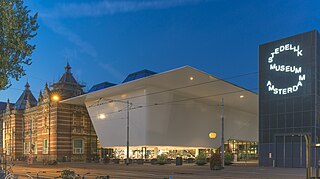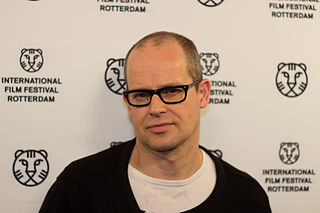
The Stedelijk Museum Amsterdam, colloquially known as the Stedelijk, is a museum for modern art, contemporary art, and design located in Amsterdam, Netherlands.

Lubertus Jacobus Swaanswijk, known professionally as Lucebert, was a Dutch artist who first became known as the poet of the COBRA movement.
Leonard van Munster is a Dutch contemporary artist making Site-specific and Subject-specific work. He studied from 1992 to 1996 at the Gerrit Rietveld Academy in Amsterdam. This included an exchange programme to Parsons School of Art and Cooper Union in New York.

Satyendra Pakhalé is an international designer, artist, industrial designer, and architect.
Mark Manders is a Dutch artist, currently living and working in Ronse, Belgium. His work consists mainly of installations, drawings and sculptures. He is probably best known for his large bronze figures that look like rough-hewn, wet or peeling clay. Typical of his work is also the arrangement of random objects, such as tables, chairs, light bulbs, blankets and dead animals.
Henk Peeters was a Dutch artist. He was an active member of the ZERO movement. Peeters was born in The Hague. He studied Fine Art at the Koninklijke Academie voor Beeldende Kunsten in The Hague and taught from 1957 until 1972 at the Art Academy in Arnhem, the Netherlands. Until his death, Henk Peeters restored artworks from the Nul period and remained an active spokesman for the Nul group.

The Cobra Museum of Modern Art is an art museum in Amstelveen in the Netherlands. The collection of the museum consists of key works by artists associated with three art movements, Vrij Beelden (1945), Cobra (1948–1951), and Creatie (1950–1955). In addition, the museum organizes temporary exhibitions by national and international avant-garde artists.

Zero was an artist group founded in the late 1950s in Düsseldorf by Heinz Mack and Otto Piene. Piene described it as "a zone of silence and of pure possibilities for a new beginning". In 1961 Günther Uecker joined the initial founders. ZERO became an international movement, with artists from Germany, the Netherlands, Belgium, France, Switzerland, and Italy.

Rob Voerman is a Dutch graphic artist, sculptor and installation artist. His works generally show futuristic architectural constructions in a post-apocalyptic world full of destruction, explosions and the remains of conflict and catastrophe.

Miguel-Ángel Cárdenas, also known as Michel Cardena, was a Colombian-Dutch, New Realism and Pop Art painter and a pioneer of video art in the Netherlands. His works cover a variety of artistic media, including painting, drawing, video, photography, object assemblages and digital art.

Erik Gerardus Franciscus van Lieshout is a Dutch contemporary artist most widely known for his installations. In 2018, he won the Heineken Prize for Art.

Han Schuil is a Dutch multimedia artist, who works in a Dutch tradition of compactness and tension in painting.

Rosa Menkman is a Dutch art theorist, curator, and visual artist specialising in glitch art and resolution theory. She investigates video compression, feedback, and glitches, using her exploration to generate art works.

Berend Strik is a Dutch visual artist working and living in Amsterdam.
Barbara Nanning is a Dutch designer, sculptor, monumental artist, ceramist and glass artist.
Melanie Bonajo (they/them) is a queer, non-binary, Dutch artist, filmmaker, feminist, sexological bodyworker, somatic sex coach and educator, cuddle workshop facilitator and animal rights activist. Through their videos, performances, photographs and installations, Bonajo examines current conundrums of co-existence in a crippling capitalistic systems, and address themes of eroding intimacy and isolation in an increasingly sterile, technological world.

The Dutch Nul Group, which consisted of Armando (1929-2018), Jan Henderikse, Henk Peeters (1925-2013) and Jan Schoonhoven (1914-1994), manifested itself in form and name in 1961. On 1 April 1961, a stone's throw from the Amsterdam Stedelijk Museum, Galerie 201 organized the ‘Internationale tentoonstelling van NIETS’. The 'Manifest tegen niets' and 'Einde' ('Ending'), a pamphlet published at the same time, were among the first activities of the Nul group. ‘We need art like we need a hole in the head,’ the pamphlet 'Einde' states; ‘From now on the undersigned pledge to work to disband art circles and close down exhibition facilities, which can then finally be put to worthier use.’ The 'Einde' pamphlet imagines a new beginning, as Armando and Henk Peeters had already proclaimed in texts written several years earlier for the Dutch Informals.
Steven Aalders is an abstract artist, known for his minimal geometric oil paintings.
Mounira Al Solh is a Lebanese-Dutch visual artist.She is represented by Sfeir-Semler Gallery.
Rory Pilgrim is a British artist who lives and works in the Netherlands and the Isle of Portland.












